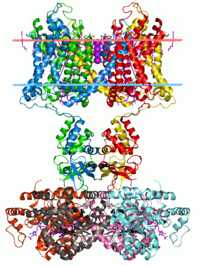
Photo from wikipedia
One of the most appealing features of [Pd2L4]4+ cages is their well-defined cavities, giving binding affinity for specific guests. If seeking to bind larger and more complex guests, an attractive… Click to show full abstract
One of the most appealing features of [Pd2L4]4+ cages is their well-defined cavities, giving binding affinity for specific guests. If seeking to bind larger and more complex guests, an attractive strategy is to lengthen the ligand backbone and therefore the inter-palladium(II) distance and cavity length. In comparison to large hollow [PdnL2n]2n+ polyhedra, this approach retains a well-ordered cavity environment. We report here a novel ligand, 1,3-bis(4-(4-ethynylpyridine)-phenyl)-adamantane, that has a hydrophobic bis(phenyl)adamantane core and forms [Pd2L4]4+ cages with a large 19 A inter-palladium(II) cavity length. This cage binds long designer anions: naphthalimide sulfonates at ≥15 A in length, which consist of two distinct domains: a naphthalimide and a phenyl sulfonate. This binding derives from hydrogen bonding between the endohedral pyridyl protons of the cage and the phenyl sulfonate group, and π–hydrophobic interactions between the adamantane core and the naphthalimide unit. The strength of binding depends on the degree of electron deficiency of the naphthalimide, brought about by the nature of substituents on this moiety, with binding constants for monoanionic guests ranging from 400 to 1800 M−1. The host/guest stoichiometry was found to be 1 : 2, unless the guest possessed a second sulfonate group, and was small enough to fit end-to-end within the cavity, in which case the stoichiometry was 1 : 1, and resulted in a high binding constant (for DMSO solvent) of 6100 M−1. This work demonstrates the subtle interplay and potential between cages and guests that are both large and that both have distinct dual zones able to interact with each other, and offers a pathway to specific and tunable binding of large guests.
Journal Title: Inorganic chemistry frontiers
Year Published: 2020
Link to full text (if available)
Share on Social Media: Sign Up to like & get
recommendations!